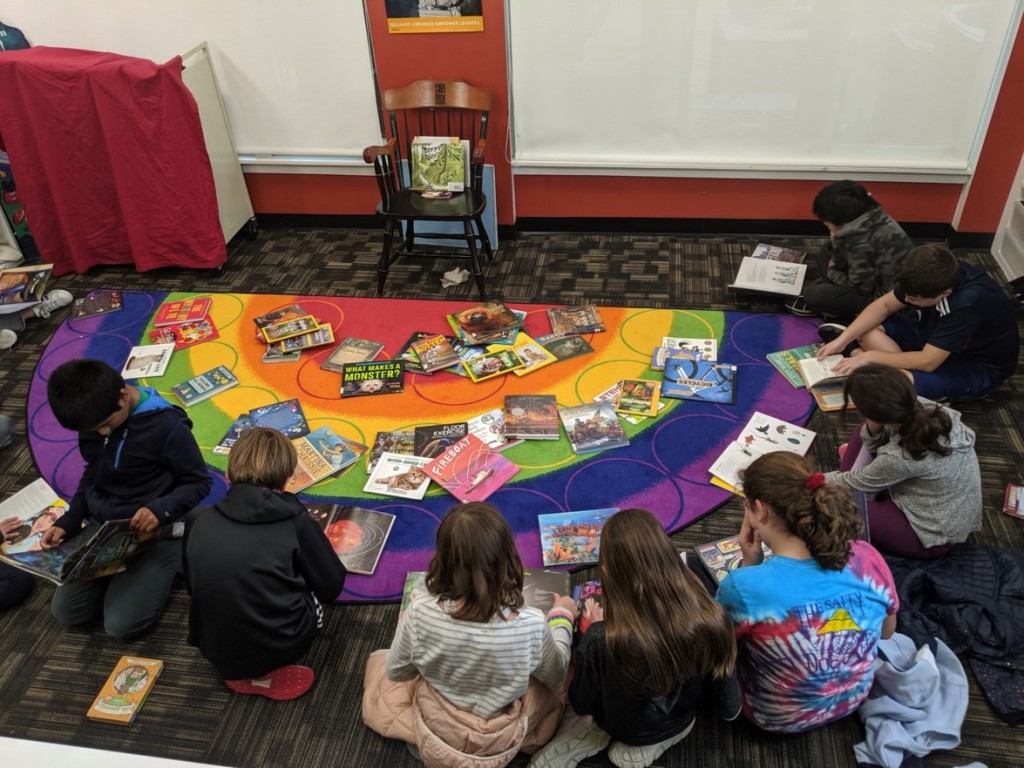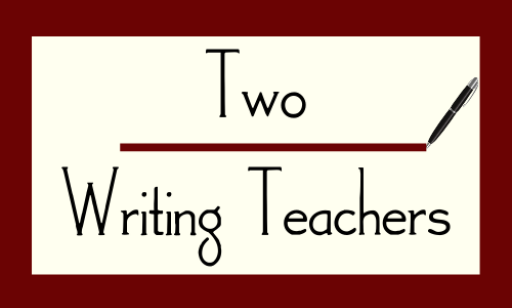My district’s curriculum plays favorites- fiction is favored. Most of my units of study revolve around understanding plot and setting, characters and theme. Yet many students self-select nonfiction books when given the opportunity to book shop. Still, when I think about the read alouds I select for my class, I would estimate 80 percent of my choices are fiction. If students love and enjoy nonfiction, can I do more to provide experiences with all types of nonfiction through independent reading and class read alouds? After reading 5 Kinds of Nonfiction, I know the answer is YES! and that it is something I need to actively and intentionally work on this year.
(WARNING: Reading 5 Kinds of Nonfiction will greatly expand your TBR list (TBR=”To be read”) and probably cost you some money as you will want to add so many fabulous nonfiction titles to your classroom library. Proceed with caution. )

The book opens with an overview of what nonfiction is with some history of how the term came into play. Two nonfiction writing styles are identified: expository nonfiction and narrative nonfiction. Stewart and Correia explain, “Narrative nonfiction appeals strongly to fiction lovers because it includes real characters, and settings, scenes, and ideally, a narrative arc with rising tension, a climax and a resolution”(6). They also clarify, “Expository nonfiction shares ideas and information in a more direct, straightforward way”(6). Most chapters includes an activity or more for teachers to try with students. The activities can be adapted to different grade levels and include suggestions for nonfiction picture books to use with the lesson.
Chapter 2 focuses on the 5 Kinds of Nonfiction classification, created by Melissa Stewart. The 5 Kinds of Nonfiction include active, browseable, traditional, expository literature and narrative. Each type is described in depth with recommended nonfiction picture books for each category.
I found Chapter 3 to be very fascinating. It is all about why students need access to a wide array of nonfiction. A case is made that most teachers and librarians have a narrative preference and often only share narrative nonfiction books. Yet, most students who were surveyed preferred expository nonfiction. This paragraph really struck me:
“Based on her experiences with young analytical thinkers, Melissa became concerned that the reading preferences of these students- the scientists, engineers, mathematicians, accountants, computer programmers, electricians, and plumbers of the future- were being undervalued, or even ignored, by educators” (27).
Reflecting on my own practices, I knew this to be true for me. I love stories. As Kate DiCamillo writes in The Tale of Desperaux, “Stories are light. Light is precious in a world so dark.” However, this chapter made me see that not every student feels the way I do about stories. According to the research Melissa did, 42% of students prefer expository books.

Chapter 4 is entitled, “How Understanding the 5 Kinds of Nonfiction Helps Readers and Writers.” There are two activities to try with students to help them learn about the 5 kinds of nonfiction. The chapter also includes a chart I loved which identifies the best type of nonfiction category for a student’s purpose. For example, if a student wanted to learn a new skill, active nonfiction is suggested. If a student wanted to share a fascinating fact with a friend, browseable nonfiction is the recommendation. Another fabulous chart in this chapter organizes craft moves with the best kind of nonfiction to teach it and the reason why. For example, a carefully chosen text structure would best be shown through expository literature.
Chapters 5-7 include lessons for teaching specific aspects of nonfiction. Chapter 5 is about exploring text patterns, Chapter 6 focuses on text structures, and Chapter 7 describes voice, language and point of view. Each of these chapters include photographs of children’s work, book recommendations, and lessons and activities to try with students. These chapters are full of lessons for reading and writing and I am excited to try them out this year with my third grade students.

Chapter 8 is all about ways to build book love for nonfiction. This was one of my favorite chapters! There are so many fun ideas to build interest and excitement around nonfiction. I especially liked the idea of the Nonfiction Smackdown, where students read two nonfiction books on the same topic.
The last chapter of the book, Chapter 9, details what “blended nonfiction” is as well as “gateway nonfiction.” The authors explain that knowing the 5 Kinds of Nonfiction helps students have ownership and “puts students in the driver’s seat” (144). They write: “It helps them understand their reading strengths and challenges, and it encourages them to stretch and grow as readers…That’s our end game. It’s what we hope for all children…because before a child can become a confident, lifelong reader, they must first be able to successfully interact with a broad range of fiction and nonfiction texts” (144).
5 Kinds of Nonfiction also includes an extensive Appendix and Bibliography of Children’s books. (Remember that warning I gave before? Be especially wary of this section!)
I learned so much from reading 5 Kinds of Nonfiction. The authors descriptions of each type of nonfiction with examples of children’s picture books really helped me understand the classification. I am more aware of how I favor narrative nonfiction and will look for ways to balance out my read alouds and book talks with more expository choices. The lessons and activities all align with my views of immersing children in real books and real purposes for writing. I highly recommend 5 Kinds of Nonfiction for educators who want to dive deeper into the world of nonfiction and present more options and possibilities for students.


Giveaway Information
Many thanks to Melissa Stewart for donating one copy of 5 Kinds of Nonfiction: Enriching Reading and Writing Instruction with Children’s Books.
For a chance to win a copy of 5 Kinds of Nonfiction, please leave a comment on this blog post by Thursday, September 2nd by 11:59 PM (EDT). I will use a random number generator to select a winner. It will be announced in the comments of this post by Saturday, September 4th.
Please leave a valid email address when you post your comment so I can contact you to obtain your mailing address. Only mailing addresses in the continental US are eligible for this giveaway.
If you are the winner of this book, I will email you with the subject line of- TWO WRITING TEACHERS- 5 KINDS OF NONFICTION. Please respond to the email within 5 business days. A new winner will be chosen if a response isn’t received within 5 days of the announcement.



Congratulations to Tessa Bohner who is the winner of the giveaway for 5 Kinds of Nonfiction! Thank you all for your interest and thoughtful comments!
LikeLiked by 1 person
This sounds and looks like an amazing resource and compliment to the work I do as a literacy coach.
It would really support our planning, prep and understanding of how to implement Readers Workshop in
the most meaningful way.
LikeLiked by 1 person
This sounds like it would be ideal for helping me to teach both staff and students at my little school in India!
LikeLiked by 1 person
This is such an important book. As a teacher that tries to explain all the different ways a nonfiction can be nonfiction– and find that there is not much out there for teachers to use that DOES explain All the types of non-fiction. I would love a copy of this book.
LikeLiked by 1 person
I’d love to have a copy of this book! It’s been on my must-read list for a while!
LikeLiked by 1 person
I love the Smackdown idea and think it would work so well during our reading version of “March Madness.”
LikeLike
This book has been on my wish list for a couple months! Would love to have it!
LikeLike
I listened to Melissa talk about her book before it came out and would love to have a copy. She is so helpful with practical and useful ideas and helped me think more about how I present books to my students. I am excited to dive into the types of nonfiction with them this year!
LikeLike
I’ve been following Melissa’s journey of this book and appreciate the chance to win a copy. I also figured that once I read it I’d want to purchase many of the books mentioned, but loved the warning in your post! ❤️📚
LikeLike
I would love to read this book!
LikeLike
This looks amazing. I need this.
LikeLike
Such an excellent resource for teachers, librarians, and kid lit writers. Students need more nonfiction choices. Classrooms need diverse library collections with a variety of nonfiction titles.
Thank you for this review and giveaway opportunity.
LikeLike
Such an excellent resource for teachers, librarians, and kid lit writers. Students need more nonfiction choices. Classrooms need more nonfiction titles for diverse library collections. Thank you for the review and giveaway opportunity.
Suzy Leopold
LikeLike
Such an excellent resource for teachers, librarians, and kid lit writers. Classrooms need more nonfiction choices for students that create diverse library collections.
Thank you for the excellent review and opportunity for a giveaway.
Suzy Leopold
sleopold@gmail.com
LikeLike
Can’t wait to read The Five Kinds of Nonfiction. My son who has loved nonfiction his whole life thrives as a reader because of nonfiction. As a teacher of beginning readers I need to realize how important this genre is to new readers. It hooked my son into reading who is now beginning his journey as a teacher of history.
LikeLike
I’d love to use this with my reading skills classes. I need to pass on my love of nonfiction to my students.
LikeLike
I’ve loved sharing many of Melissa Stewart’s books with students! This is such a wonderful tool for teachers. Thank you for bringing it to my attention. Two Writing Teachers always comes through with great info.
LikeLike
Hello! I’m planning on doing an enrichment class exploring the 5 kinds of nonfiction. 🙂
LikeLike
I love sharing nonfiction with kids and they love it too!! I can’t wait to read this book!
LikeLike
I’m eager to learn more about how to use nonfiction children’s literature to inspire writing!
LikeLike
Thank you for the chance to win! Always looking for non-fiction resources!
LikeLike
I have been blessed to have heard Melissa Stewart speak about the five types of nonfiction. She definitely raised my awareness of the content of my class library. This professional book has been on my “to read” list for quite some time. I am looking forward to learning more about this important topic soon.
LikeLike
You are 110% right, Kathleen! Just because we love stories and favor them does not mean all children, all people feel or think the same. Melissa Stewart is a brilliant as she reminds and encourages us to think broadly! Thank, you!
LikeLike
This is awesome! I would really like to work these into my library lessons. 🙂
LikeLike
I would love to learn more! Can’t wait to read this book!
LikeLike
I am always interested in following new pathways that will encourage writers to travel the nonfiction writing road. This text appears to be the ticket!
LikeLike
Very interesting. Looking forward to reading this and introducing this to the class as we discuss genre. I’ll be making better categories for my non-fiction books and hopefully adding many more titles!
LikeLike
I appreciate learning about the book, 5 Kinds of Nonfiction, in your review. I am a new literacy coach this year and would love to share this book with the teachers I will be working with.
LikeLike
I love to read Melissa Stewart’s thoughts about nonfiction. It’s time to add more to my classroom.
LikeLike
Wow! I never knew there were more types of nonfiction than just narrative and expository! I am definitely the type of teacher for whom this book was written. Although I have non-fiction in my classroom library I rarely highlight it. I will definitely be changing what I do after reading this review. Thank you for sharing.
LikeLike
I cannot wait to read and use this book to help me with my students! Many of my first and second graders love nonfiction, but quite a few need a little nudge in that direction!
LikeLiked by 1 person
I am so excited to get my hands on a copy of this book! I feel like I have so much to learn…and I can’t wait! Thank you for the opportunity to win a copy.
LikeLike
I am so excited about this book. I love Melissa Stewart’s work for children (and was fortunate to read quite the number of her books this summer with our three grandchildren), yet especially look forward to reading this as an educator. The information will help teachers support children on reading and writing.
LikeLike
I’ve been wanting to get my hands on this book ever since I read about it! Thanks so much for the review and for the chance to win a copy. It sounds like a fabulous resource!
LikeLike
Right when I thought I was going to be able to curb my “new book” addiction, THIS gem comes along! I love nonfiction and am really intrigued to dive in and learn more about the 5 kinds of nonfiction instruction.
LikeLike
I am so excited about this book! I cannot wait to dig in and learn more about how to enhance the “nonfiction experience” with my students.
LikeLike
Over 10 years ago, Common Core standards pointed out the need to use more expository text in our teaching.
As a veteran teacher and librarian who’s spent years working with elementary students, it was always clear that many students, especially those reluctant readers, preferred nonfiction. I have been following Melissa Stewart’s website and using her books for years. It will be great to have all her resources/ideas in a professional text.
LikeLike
What a wonderful learning opportunity for all of us. Can’t wait to get my hands on a copy!
LikeLike
Kathleen! Love this review and it definitely has me intrigued about the new research. Thanks for sharing this with the TWT world 🙂
LikeLiked by 1 person
Thanks Lanny! Miss you.
LikeLiked by 1 person
I bought one copy and love this book. The practical suggestions and titles are wonderful. I would appreciate being able to enter the drawing so that I can hold on to my copy and give one to my daughter, who teaches a different grade level and school.
LikeLike
This book would be a great resource. Thank you for sharing.
LikeLike
I watched a webinar about the 5 Kinds of Nonfiction and would love to have this book.
LikeLike
This is a must have book for all of teaching ELA (and even content teachers who can address reading informational text in their classes)!
Can’t wait to get my hands on a copy!
LikeLike
looks like a fabulous resource. I would love to win a copy!
LikeLike
I’m so excited about this book! I love Melissa Stewart’s work and can’t wait to share this resource with colleagues.
LikeLike
I’m so excited to get my hands on this text, not only for me as the Reading Specialist, but for all of my teachers.
LikeLiked by 1 person
I would love to win this book. As a librarian, I used Melissa’s website and resources to share non-fiction books with teachers and students. I love the 5 kinds of non-fiction and have created an activity for my students based on the concept. I heard Melissa speak at the AASL conference in 2019 – she is a wonderful presenter and speaker.
LikeLiked by 1 person
Oh, this is going to be a must-read for me. Scanned my bookshelves at home…95% fiction. The shelves at school, still not nearly balanced enough.
LikeLike
The ability to successfully navigate and make meaning of a variety of nonfiction texts is such a critical reading skill — even more so in today’s world. I look forward to reading this much needed, timely offering.
LikeLike
Guilty! I lean way more on fiction. I have added a few nonfiction books to my classroom library but need to continue with lots more.
LikeLike
This book sounds amazing!! 🙌🏼 Cannot wait to get my hands on it☺️
LikeLiked by 1 person
What a timely post! How great to start the new year with a wealth of support for non-fiction. Thank you for your post and thank you to the authors for penning this resource. Special thanks to Melissa Stewart for donating a copy to one of your readers.
LikeLiked by 1 person
I love reading Melissa Stewart’s books and I am super excited about this new PD book. This topic is definitely an area of need!
LikeLike
This will be a great resource! Now I can’t decide whether or not to just run out and get this book today or wait until next week.
LikeLiked by 1 person
Melissa is a brilliant ambassador for the wonderful world of non-fiction. A gift!
LikeLike
I LOVE all nonfiction and so do my readers!
LikeLike
Sounds like an informative read! Thank you for the review and giveaway!
LikeLike
Hi Melissa. I saw you present on this topic at the SLJ Day of Dialogue a few years again and happy to hear it’s in print. Congratulations! I’d love a copy to deepen my understanding and have as a handy reference.
LikeLike
Looking forward to reading through this…thanks for sharing!
LikeLike
This could be a great supplemental text in one of the literacy courses I teach preservice teachers. Wonder if there’s a chapter dedicated to vocabulary development through nonfiction?
LikeLike
Wow! I’ve been teaching reading/ writing workshop for 11 years, and I’ve only taught biography, autobiography and informational. Just yesterday we got into a discussion about Magic School Bus, and how it spans at least two genres. I love the concept of opening up more categories for nonfiction text!
LikeLike
This book looks amazing! I think my second grade students will enjoy learning all the different types of non fiction. Thank you!
LikeLike
So happy to see a book like this! Our district places a strong emphasis on “Informational text” and teaches the signposts for many non-fiction volumes. The kids are able to apply what they have learned in the classroom, in their library class! Score!
LikeLike
This looks like a great resource to help me better teach the nonfiction parts of our curriculum! Jan Sharp sharpj@mcsin-k12.org
LikeLike
This would be great to add to my TBR pile! Nonfiction can be presented in different ways and I like that this is addressed!
LikeLike
Wow, this sounds like a great book to read and use!
LikeLike
I want to read this book! My district curriculum focus is fiction but I do see many students choosing nonfiction books for reading. I would love to learn more about ways to incorporate more nonfiction into my reading and writing workshops.
LikeLike
I love thinking about author’s purpose for the students to then write in that type of nonfiction. It also makes us aware to expose a variety of nonfiction texts with our students!
LikeLike
This is just the type of book I need to build our mentor text library! Non-fiction books have come a long way over the years and are so engaging for readers because of the attention to graphics and text. Looking forward to adding this to our professional library!
LikeLike
Sounds like a great read and one that will really benefit teachers and the students they teach.
LikeLike
This book looks great! I’d love to read and use ideas and books with kids!
LikeLike
Thank you very much for the review of this book. I love Melissa Stewart and have been reading her nonfiction books to my class for years now… she has quite the variety of nonfiction authored books! I have been thinking about buying this book for several weeks now, and this review sold me. This is the exact content I need to help my third grade students grow even more as writers!
LikeLike
When I moved from 7th grade to 8th grade, one of the biggest differences was the availability of “appropriate” non-fiction texts that were really engaging. I am sure I could have found them for my 7th graders, but the one year difference seemed to be huge! I love the potential of this text….putting it on my must-read! Thank you for the thoughtful post!
LikeLike
I have been tutoring a middle schooler during the pandemic who is a reluctant reader, but definitely prefers NF. This seems to be exactly what I need to engage her. Thanks for the give away.
LikeLiked by 1 person
This book looks like a fabulous resource! My students typically love nonfiction but I have never taught about 5 specific types of nonfiction. Interesting!
LikeLike
I follow Melissa Stewart’s blog and always appreciate her insights into nonfiction! I would love to have a copy of this book to add to my professional books! 🙂
LikeLike
Such a great book to clarify the different kinds of non-fiction and suggestions for books. Thank you for the giveaway!
LikeLike
Building a love of reading is often the greatest challenge for an elementary school teacher. For many children I have found non – fiction a wonderful way to engage readers and find topics that they love. In life we read more non fiction as adults so exploring non fiction is a must in our classrooms!
LikeLiked by 1 person
NF read alouds so important in building background knowledge.
LikeLike
I’d love to read this!
LikeLike
What a perfect text! Teachers have spent hours trying to find examples and to have them evaluated and shared by these authors? Fantastic!
LikeLike
This is exactly the book that all teachers of ELA need to bring nonfiction reading into the light it deserves. I attended Melissa’s engaging session at nerdcamp and as a fiction “snob” she opened my eyes. I would love to win a copy of this.
LikeLike
Up in the middle of the night… just can’t sleep. SO happy to have found this review! I don’t teach children’s literature anymore, but now I want to do it again! 5 Kinds of Reading Instruction will empower teachers with the knowledge and the offerings to inspire and entice young readers who don’t already KNOW they love nonfiction, and it will validate those who do! (If I just had my own copy this very minute, these sleepless hours could pass in pleasure)!
LikeLike